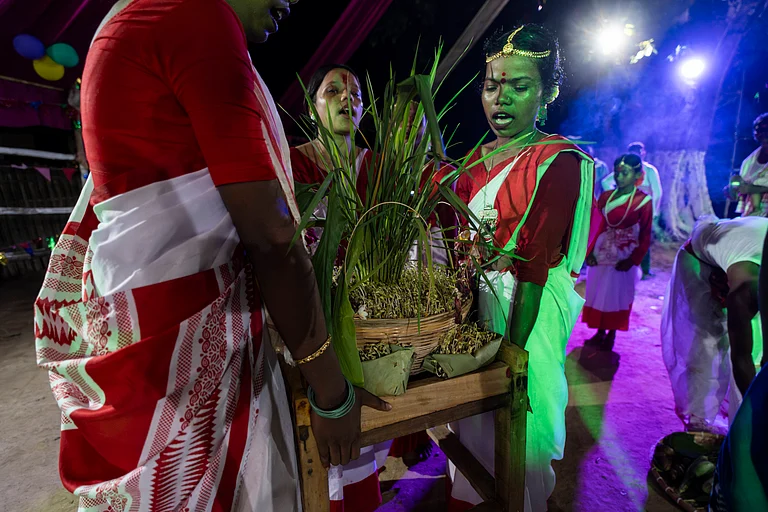Chhattisgarh’s Bastar division is again in the news for increasing tension over 'forced conversion' leading to a new episode of violence. According to media reports, on January 2 a mob vandalized a church and attacked police personnel who tried to stop them. The incident took place after a group of Adivasis organised a protest meeting against the alleged forced conversion in a village in the Narayanpur district. In a different incident on January 1, Christian Adivasis and non-Christian Adivasis in Gorra village clashed with each other leaving many villagers and some policemen injured. These two incidents of violence occurred merely two weeks after hundreds of Adivasi Christians were forcefully evicted from their villages in Narayanpur and Kondagaon districts, allegedly by right-wing groups who were trying to reconvert them to Hinduism under the name of Ghar Wapsi.
Recently there has been a series of violent incidents in villages in the Narayanpur and Kondagoan districts related to issues of forced conversion and reconversion creating an environment of tension and mistrust. A fact-finding team led by civil society representatives like Irfan Engineer, Nicholas Barla among others, after visiting more than 30 villages in both Narayanpur and Kondagaon districts where alleged attacks against the Christians took place, said in their report that there has been an ‘organised campaign’ to convert Christian Adivasis into Hinduism. However, state officials denied that the violence is related to forced religious conversion. The chain of violent incidents has led to mounting tensions between Christian Adivasis and non-Christian Adivasis in the region.
However, we need to look beyond the immediate trigger for recent incidents of violence among Adivasis. Any in-depth analysis of the sociopolitical causes which led to such incidents requires an understanding which is historically grounded and socially situated. I will try to throw some light on the increasing communal polarization and conflict between Christian and non-Christian Adivasis in Adivasi areas of central India by focusing on the following four levels of explanation: 1) the history of politics of conversion in Adivasi areas, 2) the demand for recognition of indigenous religion called Sarna, 3) rapid sociopolitical changes taking place in Adivasi areas, 4) reviving the memory of Dilip Singh Judeo.
Conversion and reconversion: The Adivasi conundrum
The accusations of forced and fraudulent conversions against the Christian organisations have acted as an important means for Hindu organisations especially Rashtriya Swayamsevak Sangh (RSS) to oppose and curtail the works of Christian missionaries in Adivasi areas since colonial times. The setting up of the Vanvasi Kalyan Ashram (VKA) in Jaspur in present day Chattishgarh, the main front of the RSS which deals with Adivasis, in 1952 is inextricably tied to their opposition to Christian missionaries. According to social anthropologist Peggy Froerer, since the formation of VKA in 1952, it has spread across Adivasi areas with the two-fold strategy: first, to bring Adivasis into the Hindu mainstream by revealing to them their ‘true’ identity as ‘Hindus’; secondly, to counteract minority Christian cultures that have taken Adivasis away from the Hindu fold. VKA, along with other affiliates of Sangh Parivar such as Seva Bharti, has worked continuously among Adivasis for decades in the fields of education and health to thwart the Christian missionary activities of health and education provisioning.
In the l990s, when the anti-Muslim sentiments started swelling, there was renewed attention directed toward Christians across India among the right-wing organisations, with special focus on Christian Adivasi communities. The reason for this attention revolved around the view that Christians, as foreigners and non-Hindus, pose a threat to the national Hindu majority because they are engaging in divisive and subversive activities, particularly against Adivasis. The part of the broader interest of RSS in Adivasis is thus related to the wider threat that Christians and other non-Hindu communities present to the political and cultural unity and supremacy of Hindus in India. In response, campaigns like Ghar Wapsi were launched in Adivasi regions across central India to ‘reclaim the souls’ of Adivasi Christians who had strayed due to conversion.
The competition between the Church and Hindu nationalist organisations have created fissures within the Adivasi community on religious lines. The recent incidents in Chhattisgarh are testimony to the deepening of the old process of Adivasi communalisation, which now threatens to turn violent at any moment with the slightest of provocations.
Sarna Code: Recognition for separate Adivasi religion
On 11 November 2020, the Jharkhand Legislative Assembly in a special session passed the ‘Sarna Code’ resolution for the inclusion of a separate religion code for indigenous religion (Sarna) in the now pending 2021 Census. The majority of Adivasis practice a distinct religion based on nature worship and animism, however, their distinctive religion is not recognised in the census operations. The Sarna Adivasi Dharam resolution passed by the Jharkhand government seeks to provide recognition to the religion of Adivasis. This resolution is an affront to the politics of the Hindutva brigade, which considers Adivasis as essentially Hindus.
RSS prefers the term ‘Vanvasi’ (forest-dwellers) rather than Adivasi which is a more politically charged term demanding separate identity. RSS has worked in the Adivasi areas with the firm belief that Adivasis are nothing but ‘backward Hindus’ and necessary reform would bring them into the mainstream Hinduism. Presence and popularity of Christian missionaries in the Adivasi areas was the original trigger that led to increased attention among the Hindu organisations towards Adivasis. The tension between Christian and Hindu missionary activities in the Adivasi areas has reached extreme proportions in the present times.
Recognising the urgency of a separate Sarna Code in the census, Adivasi organisations and activists have been mobilizing Adivasis demanding recognition for their religion. Understanding the popularity of the demand, Hemant Soren, the chief minister of Jharkhand, passed the Sarna Code resolution, which is now pending with the Union government.
The recognition of indigenous religion could prove to be the fulcrum of increased Adivasi solidarity and counteract any attempt to assimilate Adivasis into majoritarian religion. However, since the passage of the resolution the political cauldron in Adivasi areas is simmering with Adivasi organisation aiming for increased Adivasi solidarity, whereas right wing organisations accusing Church for dividing Adivasis and engaging in fraudulent religious conversions. The Chhattisgarh case is a manifestation of the brewing political tensions in the Adivasi areas.
Socio-political and economic changes in Adivasi areas
The Adivasi areas have witnessed large scale socio-economic changes in recent times. A large section of the younger generation of Adivasis has received formal education. Education, along with the increase in road connectivity and reach of digital media, has created a section of highly aspirational Adivasi youth whose politics could not be subsumed by the politics of Jal Jangal and Jameen. They don’t want to work in fields like their older generation, they move in all directions and negotiate with different kinds of politics seeking new futures for themselves. Hindutva politics is one of the many platforms with which Adivasi youth have started to negotiate for a better future.
There is another related story of increasing socio-economic differentiation within the Adivasi community. Some of the educated sections of the Adivasis have been able to access the benefits of reservation and get government jobs. A significant part of this upwardly mobile section in Jharkhand and Chhattisgarh are Christian Adivasis who get good education in missionary schools. During my field visits to the Khunti and Ranchi districts in Jharkhand, I found that the socio-economic mobility of Christian Adivasis is one of the important causes of the increasing friction within the Adivasi communities, which is then exploited by various political outfits operating in the region.
Reviving the memory of Dilip Singh Judeo
RSS chief Mohan Bhagwat visited Chhattishgarh in mid-November last year for a four-day trip. One of the important events he attended during his visit was unveiling the statue of the former Union minister Dilip Singh Judeo who was known for his strong stance against Christian missionaries and popularized the notion of Ghar Wapsi by bringing back the Adivasis into the Hindutva fold. The event symbolized the RSS attempt to rekindle Judeo's memory and politics at a time when the demand for the recognition of a distinct Adivasi religious identity has gained immense popularity. It is not surprising that the issue of religious conversion has been gaining more traction since then.
The contemporary socio-economic and political change in the Adivasi areas is giving the older politics of religious conversion and reconversion a renewed life. With the assembly elections in Chhattisgarh and Madhya Pradesh likely this year and Jharkhand and Odisha next year, the political field in the Adivasi region will keep simmering.


























